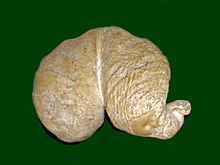| Diceras Temporal range: From Jurassic to Cretaceous, | |
|---|---|
 | |
| Fossil Diceras angulatum from Jurassic at Galerie de paléontologie et d'anatomie comparée, Paris | |
| Scientific classification | |
| Domain: | Eukaryota |
| Kingdom: | Animalia |
| Phylum: | Mollusca |
| Class: | Bivalvia |
| Order: | † Hippuritida |
| Suborder: | † Hippuritidina |
| Superfamily: | † Radiolitoidea |
| Family: | † Diceratidae |
| Genus: | † Diceras Lamarck, 1805 |
| Species | |
See text. | |
Diceras is an extinct genus of fossil saltwater clams, marine heterodont bivalve molluscs. These bivalves were stationary epifaunal suspension feeders.